Akbank's IT and Customer Service Crisis: A Comprehensive Analysis
VerifiedAdded on 2021/11/17
|7
|3234
|27
Report
AI Summary
This report provides a comprehensive analysis of the IT and customer service crisis experienced by Akbank, a leading Turkish bank. The assignment begins with an overview of Akbank's mission, vision, and general information, highlighting its digital banking services and global recognition. The core of the report focuses on the 2021 crisis, detailing the technical malfunctions, communication breakdowns, and the failure of backup systems. The analysis delves into the root causes, including decision-making processes, information technology management, human resources management, and corporate communication failures. The report examines the lack of a well-defined crisis management plan, insufficient communication with employees and customers, and the impact of these issues on Akbank's reputation. Finally, the report offers potential solutions, emphasizing the importance of transparent communication, effective decision-making, robust backup systems, and improved employee training to prevent similar crises in the future. The report highlights the importance of a well-prepared crisis management plan, internal communication and a robust IT infrastructure.
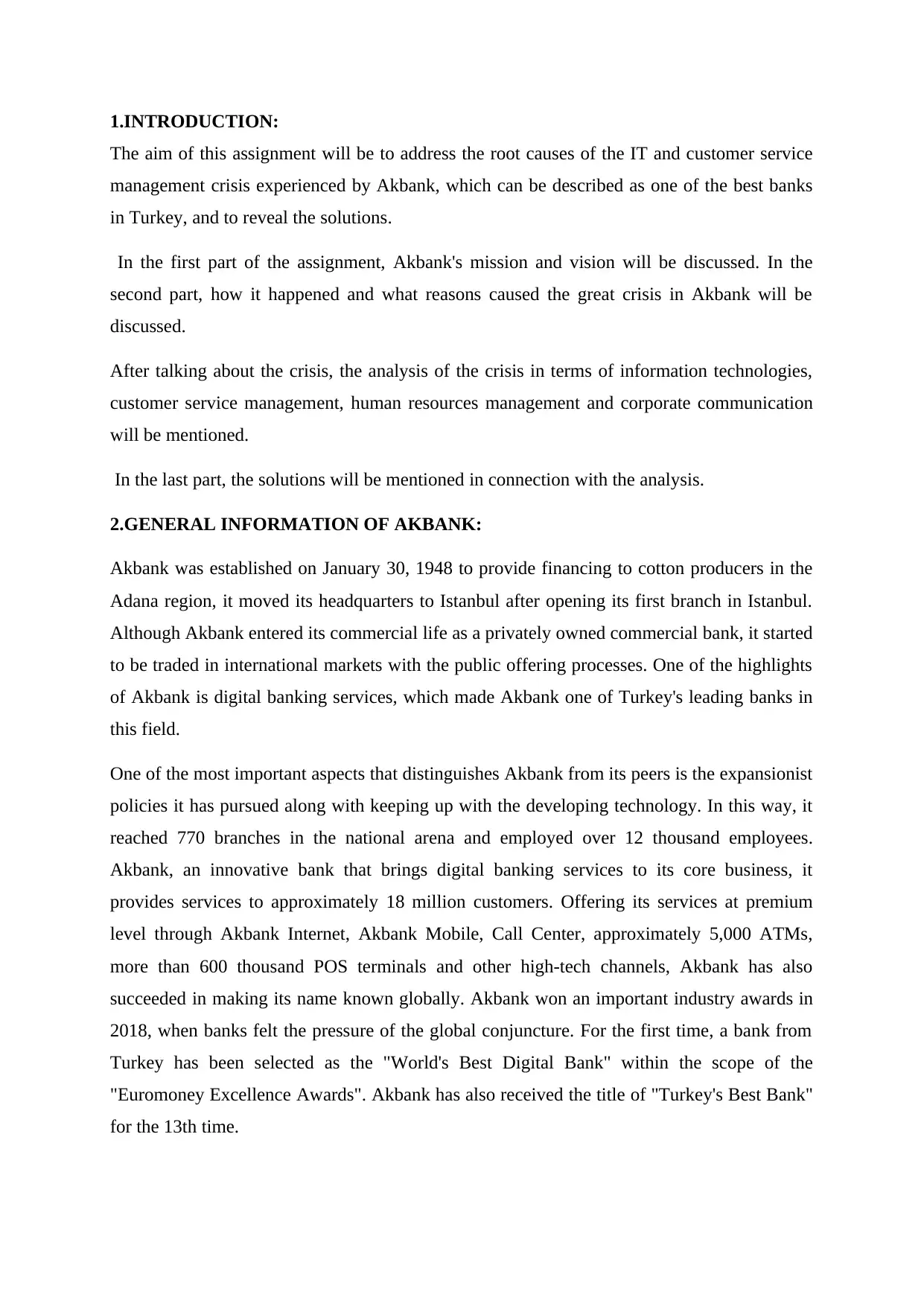
1.INTRODUCTION:
The aim of this assignment will be to address the root causes of the IT and customer service
management crisis experienced by Akbank, which can be described as one of the best banks
in Turkey, and to reveal the solutions.
In the first part of the assignment, Akbank's mission and vision will be discussed. In the
second part, how it happened and what reasons caused the great crisis in Akbank will be
discussed.
After talking about the crisis, the analysis of the crisis in terms of information technologies,
customer service management, human resources management and corporate communication
will be mentioned.
In the last part, the solutions will be mentioned in connection with the analysis.
2.GENERAL INFORMATION OF AKBANK:
Akbank was established on January 30, 1948 to provide financing to cotton producers in the
Adana region, it moved its headquarters to Istanbul after opening its first branch in Istanbul.
Although Akbank entered its commercial life as a privately owned commercial bank, it started
to be traded in international markets with the public offering processes. One of the highlights
of Akbank is digital banking services, which made Akbank one of Turkey's leading banks in
this field.
One of the most important aspects that distinguishes Akbank from its peers is the expansionist
policies it has pursued along with keeping up with the developing technology. In this way, it
reached 770 branches in the national arena and employed over 12 thousand employees.
Akbank, an innovative bank that brings digital banking services to its core business, it
provides services to approximately 18 million customers. Offering its services at premium
level through Akbank Internet, Akbank Mobile, Call Center, approximately 5,000 ATMs,
more than 600 thousand POS terminals and other high-tech channels, Akbank has also
succeeded in making its name known globally. Akbank won an important industry awards in
2018, when banks felt the pressure of the global conjuncture. For the first time, a bank from
Turkey has been selected as the "World's Best Digital Bank" within the scope of the
"Euromoney Excellence Awards". Akbank has also received the title of "Turkey's Best Bank"
for the 13th time.
The aim of this assignment will be to address the root causes of the IT and customer service
management crisis experienced by Akbank, which can be described as one of the best banks
in Turkey, and to reveal the solutions.
In the first part of the assignment, Akbank's mission and vision will be discussed. In the
second part, how it happened and what reasons caused the great crisis in Akbank will be
discussed.
After talking about the crisis, the analysis of the crisis in terms of information technologies,
customer service management, human resources management and corporate communication
will be mentioned.
In the last part, the solutions will be mentioned in connection with the analysis.
2.GENERAL INFORMATION OF AKBANK:
Akbank was established on January 30, 1948 to provide financing to cotton producers in the
Adana region, it moved its headquarters to Istanbul after opening its first branch in Istanbul.
Although Akbank entered its commercial life as a privately owned commercial bank, it started
to be traded in international markets with the public offering processes. One of the highlights
of Akbank is digital banking services, which made Akbank one of Turkey's leading banks in
this field.
One of the most important aspects that distinguishes Akbank from its peers is the expansionist
policies it has pursued along with keeping up with the developing technology. In this way, it
reached 770 branches in the national arena and employed over 12 thousand employees.
Akbank, an innovative bank that brings digital banking services to its core business, it
provides services to approximately 18 million customers. Offering its services at premium
level through Akbank Internet, Akbank Mobile, Call Center, approximately 5,000 ATMs,
more than 600 thousand POS terminals and other high-tech channels, Akbank has also
succeeded in making its name known globally. Akbank won an important industry awards in
2018, when banks felt the pressure of the global conjuncture. For the first time, a bank from
Turkey has been selected as the "World's Best Digital Bank" within the scope of the
"Euromoney Excellence Awards". Akbank has also received the title of "Turkey's Best Bank"
for the 13th time.
Paraphrase This Document
Need a fresh take? Get an instant paraphrase of this document with our AI Paraphraser
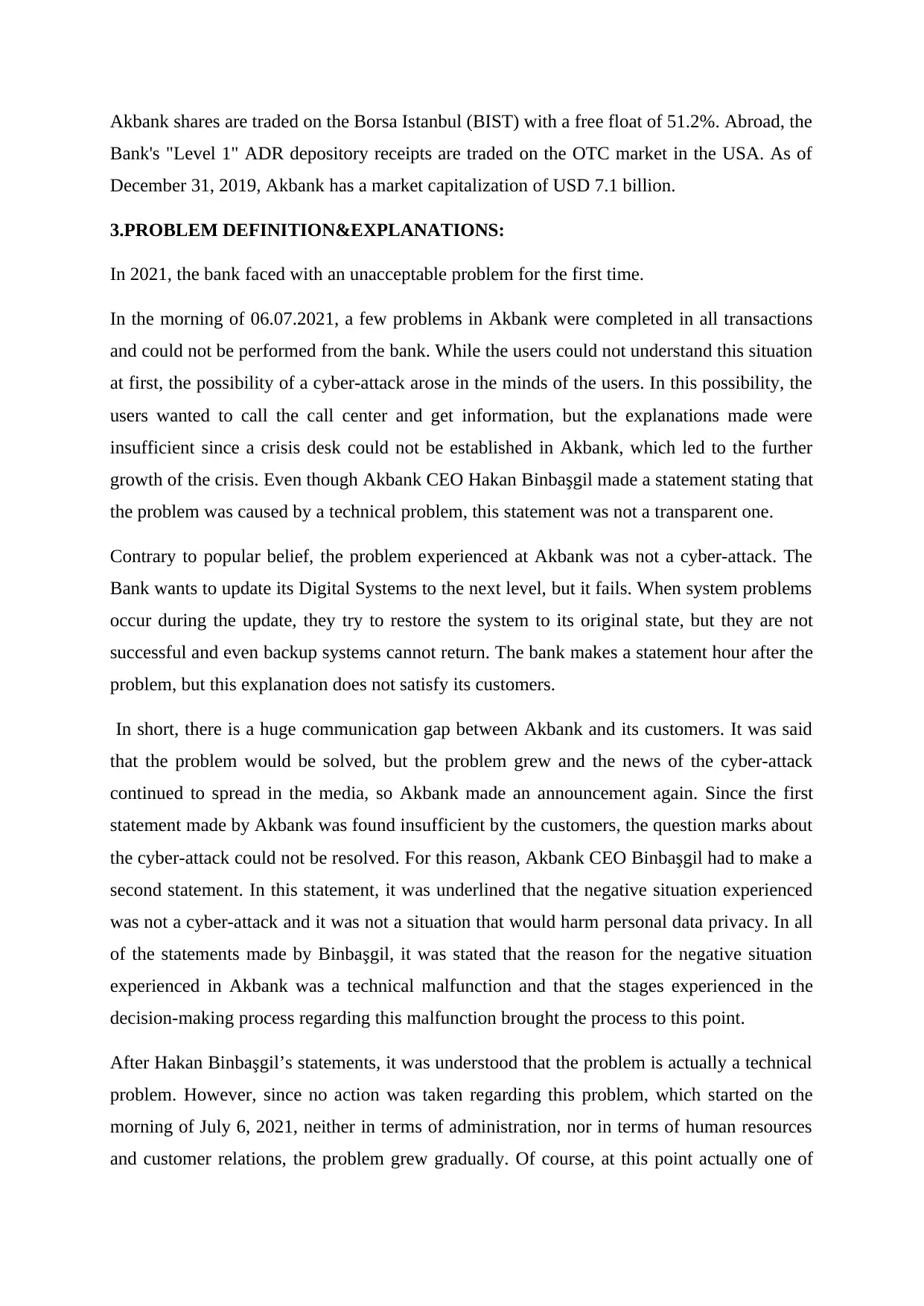
Akbank shares are traded on the Borsa Istanbul (BIST) with a free float of 51.2%. Abroad, the
Bank's "Level 1" ADR depository receipts are traded on the OTC market in the USA. As of
December 31, 2019, Akbank has a market capitalization of USD 7.1 billion.
3.PROBLEM DEFINITION&EXPLANATIONS:
In 2021, the bank faced with an unacceptable problem for the first time.
In the morning of 06.07.2021, a few problems in Akbank were completed in all transactions
and could not be performed from the bank. While the users could not understand this situation
at first, the possibility of a cyber-attack arose in the minds of the users. In this possibility, the
users wanted to call the call center and get information, but the explanations made were
insufficient since a crisis desk could not be established in Akbank, which led to the further
growth of the crisis. Even though Akbank CEO Hakan Binbaşgil made a statement stating that
the problem was caused by a technical problem, this statement was not a transparent one.
Contrary to popular belief, the problem experienced at Akbank was not a cyber-attack. The
Bank wants to update its Digital Systems to the next level, but it fails. When system problems
occur during the update, they try to restore the system to its original state, but they are not
successful and even backup systems cannot return. The bank makes a statement hour after the
problem, but this explanation does not satisfy its customers.
In short, there is a huge communication gap between Akbank and its customers. It was said
that the problem would be solved, but the problem grew and the news of the cyber-attack
continued to spread in the media, so Akbank made an announcement again. Since the first
statement made by Akbank was found insufficient by the customers, the question marks about
the cyber-attack could not be resolved. For this reason, Akbank CEO Binbaşgil had to make a
second statement. In this statement, it was underlined that the negative situation experienced
was not a cyber-attack and it was not a situation that would harm personal data privacy. In all
of the statements made by Binbaşgil, it was stated that the reason for the negative situation
experienced in Akbank was a technical malfunction and that the stages experienced in the
decision-making process regarding this malfunction brought the process to this point.
After Hakan Binbaşgil’s statements, it was understood that the problem is actually a technical
problem. However, since no action was taken regarding this problem, which started on the
morning of July 6, 2021, neither in terms of administration, nor in terms of human resources
and customer relations, the problem grew gradually. Of course, at this point actually one of
Bank's "Level 1" ADR depository receipts are traded on the OTC market in the USA. As of
December 31, 2019, Akbank has a market capitalization of USD 7.1 billion.
3.PROBLEM DEFINITION&EXPLANATIONS:
In 2021, the bank faced with an unacceptable problem for the first time.
In the morning of 06.07.2021, a few problems in Akbank were completed in all transactions
and could not be performed from the bank. While the users could not understand this situation
at first, the possibility of a cyber-attack arose in the minds of the users. In this possibility, the
users wanted to call the call center and get information, but the explanations made were
insufficient since a crisis desk could not be established in Akbank, which led to the further
growth of the crisis. Even though Akbank CEO Hakan Binbaşgil made a statement stating that
the problem was caused by a technical problem, this statement was not a transparent one.
Contrary to popular belief, the problem experienced at Akbank was not a cyber-attack. The
Bank wants to update its Digital Systems to the next level, but it fails. When system problems
occur during the update, they try to restore the system to its original state, but they are not
successful and even backup systems cannot return. The bank makes a statement hour after the
problem, but this explanation does not satisfy its customers.
In short, there is a huge communication gap between Akbank and its customers. It was said
that the problem would be solved, but the problem grew and the news of the cyber-attack
continued to spread in the media, so Akbank made an announcement again. Since the first
statement made by Akbank was found insufficient by the customers, the question marks about
the cyber-attack could not be resolved. For this reason, Akbank CEO Binbaşgil had to make a
second statement. In this statement, it was underlined that the negative situation experienced
was not a cyber-attack and it was not a situation that would harm personal data privacy. In all
of the statements made by Binbaşgil, it was stated that the reason for the negative situation
experienced in Akbank was a technical malfunction and that the stages experienced in the
decision-making process regarding this malfunction brought the process to this point.
After Hakan Binbaşgil’s statements, it was understood that the problem is actually a technical
problem. However, since no action was taken regarding this problem, which started on the
morning of July 6, 2021, neither in terms of administration, nor in terms of human resources
and customer relations, the problem grew gradually. Of course, at this point actually one of
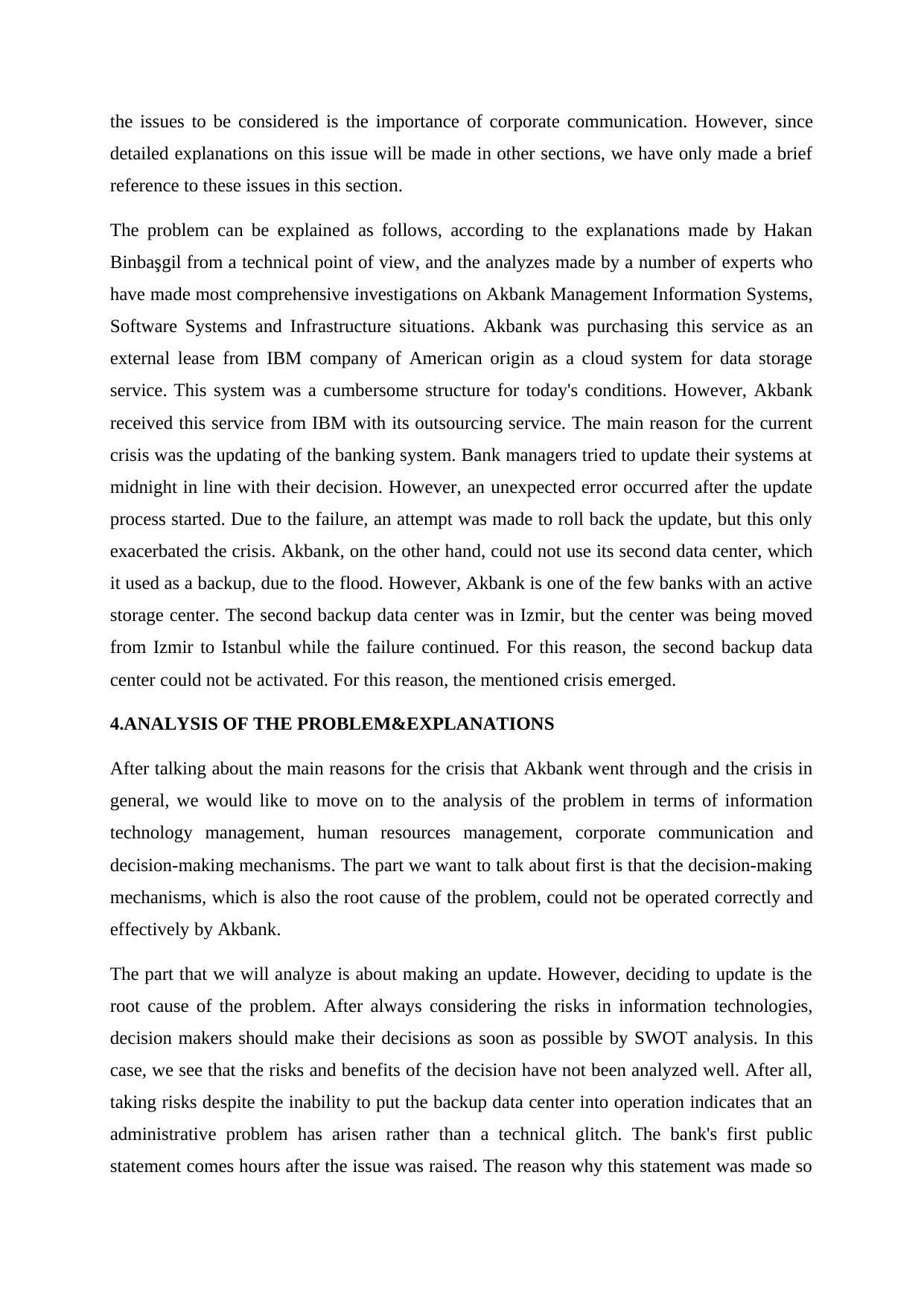
the issues to be considered is the importance of corporate communication. However, since
detailed explanations on this issue will be made in other sections, we have only made a brief
reference to these issues in this section.
The problem can be explained as follows, according to the explanations made by Hakan
Binbaşgil from a technical point of view, and the analyzes made by a number of experts who
have made most comprehensive investigations on Akbank Management Information Systems,
Software Systems and Infrastructure situations. Akbank was purchasing this service as an
external lease from IBM company of American origin as a cloud system for data storage
service. This system was a cumbersome structure for today's conditions. However, Akbank
received this service from IBM with its outsourcing service. The main reason for the current
crisis was the updating of the banking system. Bank managers tried to update their systems at
midnight in line with their decision. However, an unexpected error occurred after the update
process started. Due to the failure, an attempt was made to roll back the update, but this only
exacerbated the crisis. Akbank, on the other hand, could not use its second data center, which
it used as a backup, due to the flood. However, Akbank is one of the few banks with an active
storage center. The second backup data center was in Izmir, but the center was being moved
from Izmir to Istanbul while the failure continued. For this reason, the second backup data
center could not be activated. For this reason, the mentioned crisis emerged.
4.ANALYSIS OF THE PROBLEM&EXPLANATIONS
After talking about the main reasons for the crisis that Akbank went through and the crisis in
general, we would like to move on to the analysis of the problem in terms of information
technology management, human resources management, corporate communication and
decision-making mechanisms. The part we want to talk about first is that the decision-making
mechanisms, which is also the root cause of the problem, could not be operated correctly and
effectively by Akbank.
The part that we will analyze is about making an update. However, deciding to update is the
root cause of the problem. After always considering the risks in information technologies,
decision makers should make their decisions as soon as possible by SWOT analysis. In this
case, we see that the risks and benefits of the decision have not been analyzed well. After all,
taking risks despite the inability to put the backup data center into operation indicates that an
administrative problem has arisen rather than a technical glitch. The bank's first public
statement comes hours after the issue was raised. The reason why this statement was made so
detailed explanations on this issue will be made in other sections, we have only made a brief
reference to these issues in this section.
The problem can be explained as follows, according to the explanations made by Hakan
Binbaşgil from a technical point of view, and the analyzes made by a number of experts who
have made most comprehensive investigations on Akbank Management Information Systems,
Software Systems and Infrastructure situations. Akbank was purchasing this service as an
external lease from IBM company of American origin as a cloud system for data storage
service. This system was a cumbersome structure for today's conditions. However, Akbank
received this service from IBM with its outsourcing service. The main reason for the current
crisis was the updating of the banking system. Bank managers tried to update their systems at
midnight in line with their decision. However, an unexpected error occurred after the update
process started. Due to the failure, an attempt was made to roll back the update, but this only
exacerbated the crisis. Akbank, on the other hand, could not use its second data center, which
it used as a backup, due to the flood. However, Akbank is one of the few banks with an active
storage center. The second backup data center was in Izmir, but the center was being moved
from Izmir to Istanbul while the failure continued. For this reason, the second backup data
center could not be activated. For this reason, the mentioned crisis emerged.
4.ANALYSIS OF THE PROBLEM&EXPLANATIONS
After talking about the main reasons for the crisis that Akbank went through and the crisis in
general, we would like to move on to the analysis of the problem in terms of information
technology management, human resources management, corporate communication and
decision-making mechanisms. The part we want to talk about first is that the decision-making
mechanisms, which is also the root cause of the problem, could not be operated correctly and
effectively by Akbank.
The part that we will analyze is about making an update. However, deciding to update is the
root cause of the problem. After always considering the risks in information technologies,
decision makers should make their decisions as soon as possible by SWOT analysis. In this
case, we see that the risks and benefits of the decision have not been analyzed well. After all,
taking risks despite the inability to put the backup data center into operation indicates that an
administrative problem has arisen rather than a technical glitch. The bank's first public
statement comes hours after the issue was raised. The reason why this statement was made so
⊘ This is a preview!⊘
Do you want full access?
Subscribe today to unlock all pages.

Trusted by 1+ million students worldwide
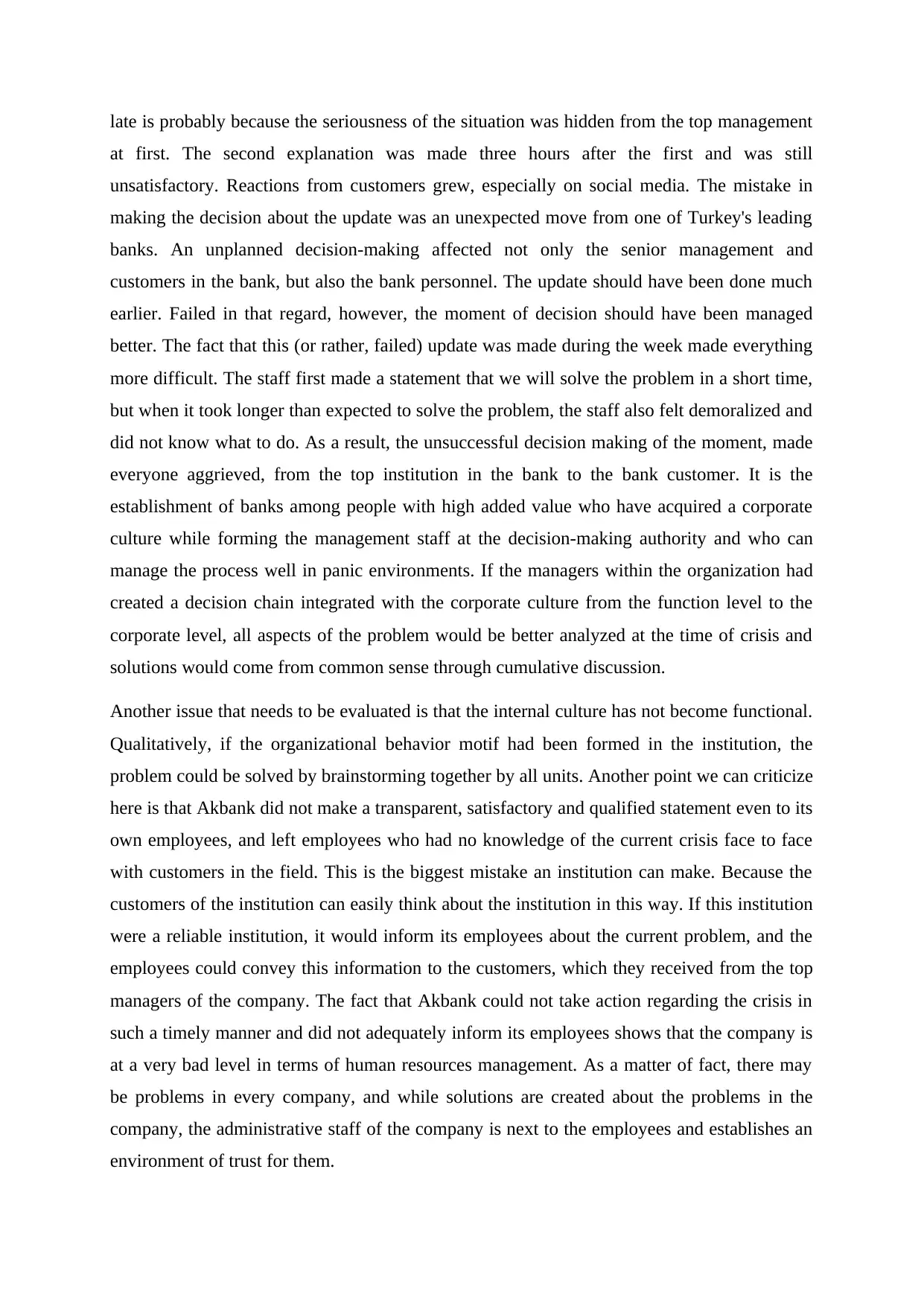
late is probably because the seriousness of the situation was hidden from the top management
at first. The second explanation was made three hours after the first and was still
unsatisfactory. Reactions from customers grew, especially on social media. The mistake in
making the decision about the update was an unexpected move from one of Turkey's leading
banks. An unplanned decision-making affected not only the senior management and
customers in the bank, but also the bank personnel. The update should have been done much
earlier. Failed in that regard, however, the moment of decision should have been managed
better. The fact that this (or rather, failed) update was made during the week made everything
more difficult. The staff first made a statement that we will solve the problem in a short time,
but when it took longer than expected to solve the problem, the staff also felt demoralized and
did not know what to do. As a result, the unsuccessful decision making of the moment, made
everyone aggrieved, from the top institution in the bank to the bank customer. It is the
establishment of banks among people with high added value who have acquired a corporate
culture while forming the management staff at the decision-making authority and who can
manage the process well in panic environments. If the managers within the organization had
created a decision chain integrated with the corporate culture from the function level to the
corporate level, all aspects of the problem would be better analyzed at the time of crisis and
solutions would come from common sense through cumulative discussion.
Another issue that needs to be evaluated is that the internal culture has not become functional.
Qualitatively, if the organizational behavior motif had been formed in the institution, the
problem could be solved by brainstorming together by all units. Another point we can criticize
here is that Akbank did not make a transparent, satisfactory and qualified statement even to its
own employees, and left employees who had no knowledge of the current crisis face to face
with customers in the field. This is the biggest mistake an institution can make. Because the
customers of the institution can easily think about the institution in this way. If this institution
were a reliable institution, it would inform its employees about the current problem, and the
employees could convey this information to the customers, which they received from the top
managers of the company. The fact that Akbank could not take action regarding the crisis in
such a timely manner and did not adequately inform its employees shows that the company is
at a very bad level in terms of human resources management. As a matter of fact, there may
be problems in every company, and while solutions are created about the problems in the
company, the administrative staff of the company is next to the employees and establishes an
environment of trust for them.
at first. The second explanation was made three hours after the first and was still
unsatisfactory. Reactions from customers grew, especially on social media. The mistake in
making the decision about the update was an unexpected move from one of Turkey's leading
banks. An unplanned decision-making affected not only the senior management and
customers in the bank, but also the bank personnel. The update should have been done much
earlier. Failed in that regard, however, the moment of decision should have been managed
better. The fact that this (or rather, failed) update was made during the week made everything
more difficult. The staff first made a statement that we will solve the problem in a short time,
but when it took longer than expected to solve the problem, the staff also felt demoralized and
did not know what to do. As a result, the unsuccessful decision making of the moment, made
everyone aggrieved, from the top institution in the bank to the bank customer. It is the
establishment of banks among people with high added value who have acquired a corporate
culture while forming the management staff at the decision-making authority and who can
manage the process well in panic environments. If the managers within the organization had
created a decision chain integrated with the corporate culture from the function level to the
corporate level, all aspects of the problem would be better analyzed at the time of crisis and
solutions would come from common sense through cumulative discussion.
Another issue that needs to be evaluated is that the internal culture has not become functional.
Qualitatively, if the organizational behavior motif had been formed in the institution, the
problem could be solved by brainstorming together by all units. Another point we can criticize
here is that Akbank did not make a transparent, satisfactory and qualified statement even to its
own employees, and left employees who had no knowledge of the current crisis face to face
with customers in the field. This is the biggest mistake an institution can make. Because the
customers of the institution can easily think about the institution in this way. If this institution
were a reliable institution, it would inform its employees about the current problem, and the
employees could convey this information to the customers, which they received from the top
managers of the company. The fact that Akbank could not take action regarding the crisis in
such a timely manner and did not adequately inform its employees shows that the company is
at a very bad level in terms of human resources management. As a matter of fact, there may
be problems in every company, and while solutions are created about the problems in the
company, the administrative staff of the company is next to the employees and establishes an
environment of trust for them.
Paraphrase This Document
Need a fresh take? Get an instant paraphrase of this document with our AI Paraphraser
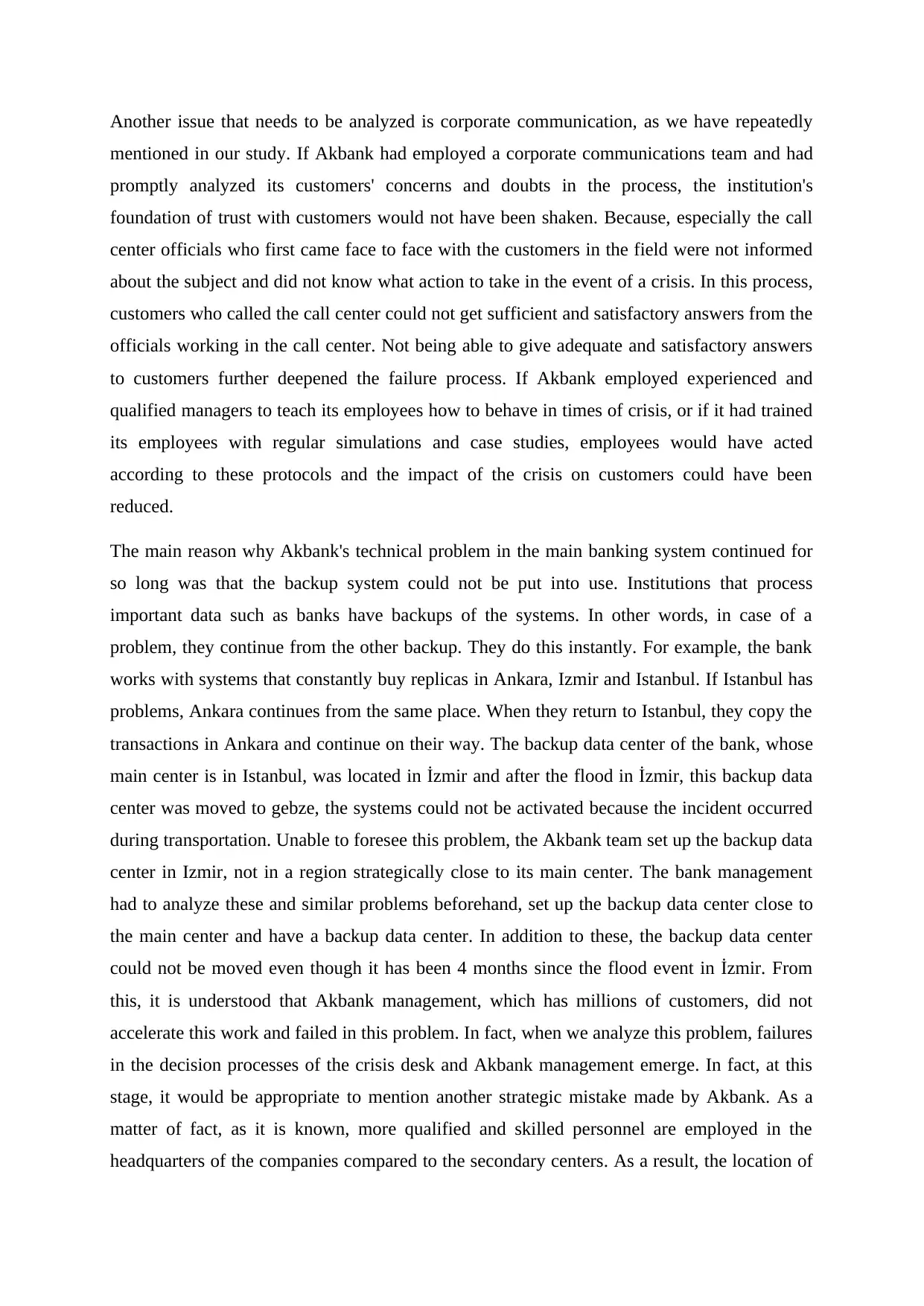
Another issue that needs to be analyzed is corporate communication, as we have repeatedly
mentioned in our study. If Akbank had employed a corporate communications team and had
promptly analyzed its customers' concerns and doubts in the process, the institution's
foundation of trust with customers would not have been shaken. Because, especially the call
center officials who first came face to face with the customers in the field were not informed
about the subject and did not know what action to take in the event of a crisis. In this process,
customers who called the call center could not get sufficient and satisfactory answers from the
officials working in the call center. Not being able to give adequate and satisfactory answers
to customers further deepened the failure process. If Akbank employed experienced and
qualified managers to teach its employees how to behave in times of crisis, or if it had trained
its employees with regular simulations and case studies, employees would have acted
according to these protocols and the impact of the crisis on customers could have been
reduced.
The main reason why Akbank's technical problem in the main banking system continued for
so long was that the backup system could not be put into use. Institutions that process
important data such as banks have backups of the systems. In other words, in case of a
problem, they continue from the other backup. They do this instantly. For example, the bank
works with systems that constantly buy replicas in Ankara, Izmir and Istanbul. If Istanbul has
problems, Ankara continues from the same place. When they return to Istanbul, they copy the
transactions in Ankara and continue on their way. The backup data center of the bank, whose
main center is in Istanbul, was located in İzmir and after the flood in İzmir, this backup data
center was moved to gebze, the systems could not be activated because the incident occurred
during transportation. Unable to foresee this problem, the Akbank team set up the backup data
center in Izmir, not in a region strategically close to its main center. The bank management
had to analyze these and similar problems beforehand, set up the backup data center close to
the main center and have a backup data center. In addition to these, the backup data center
could not be moved even though it has been 4 months since the flood event in İzmir. From
this, it is understood that Akbank management, which has millions of customers, did not
accelerate this work and failed in this problem. In fact, when we analyze this problem, failures
in the decision processes of the crisis desk and Akbank management emerge. In fact, at this
stage, it would be appropriate to mention another strategic mistake made by Akbank. As a
matter of fact, as it is known, more qualified and skilled personnel are employed in the
headquarters of the companies compared to the secondary centers. As a result, the location of
mentioned in our study. If Akbank had employed a corporate communications team and had
promptly analyzed its customers' concerns and doubts in the process, the institution's
foundation of trust with customers would not have been shaken. Because, especially the call
center officials who first came face to face with the customers in the field were not informed
about the subject and did not know what action to take in the event of a crisis. In this process,
customers who called the call center could not get sufficient and satisfactory answers from the
officials working in the call center. Not being able to give adequate and satisfactory answers
to customers further deepened the failure process. If Akbank employed experienced and
qualified managers to teach its employees how to behave in times of crisis, or if it had trained
its employees with regular simulations and case studies, employees would have acted
according to these protocols and the impact of the crisis on customers could have been
reduced.
The main reason why Akbank's technical problem in the main banking system continued for
so long was that the backup system could not be put into use. Institutions that process
important data such as banks have backups of the systems. In other words, in case of a
problem, they continue from the other backup. They do this instantly. For example, the bank
works with systems that constantly buy replicas in Ankara, Izmir and Istanbul. If Istanbul has
problems, Ankara continues from the same place. When they return to Istanbul, they copy the
transactions in Ankara and continue on their way. The backup data center of the bank, whose
main center is in Istanbul, was located in İzmir and after the flood in İzmir, this backup data
center was moved to gebze, the systems could not be activated because the incident occurred
during transportation. Unable to foresee this problem, the Akbank team set up the backup data
center in Izmir, not in a region strategically close to its main center. The bank management
had to analyze these and similar problems beforehand, set up the backup data center close to
the main center and have a backup data center. In addition to these, the backup data center
could not be moved even though it has been 4 months since the flood event in İzmir. From
this, it is understood that Akbank management, which has millions of customers, did not
accelerate this work and failed in this problem. In fact, when we analyze this problem, failures
in the decision processes of the crisis desk and Akbank management emerge. In fact, at this
stage, it would be appropriate to mention another strategic mistake made by Akbank. As a
matter of fact, as it is known, more qualified and skilled personnel are employed in the
headquarters of the companies compared to the secondary centers. As a result, the location of
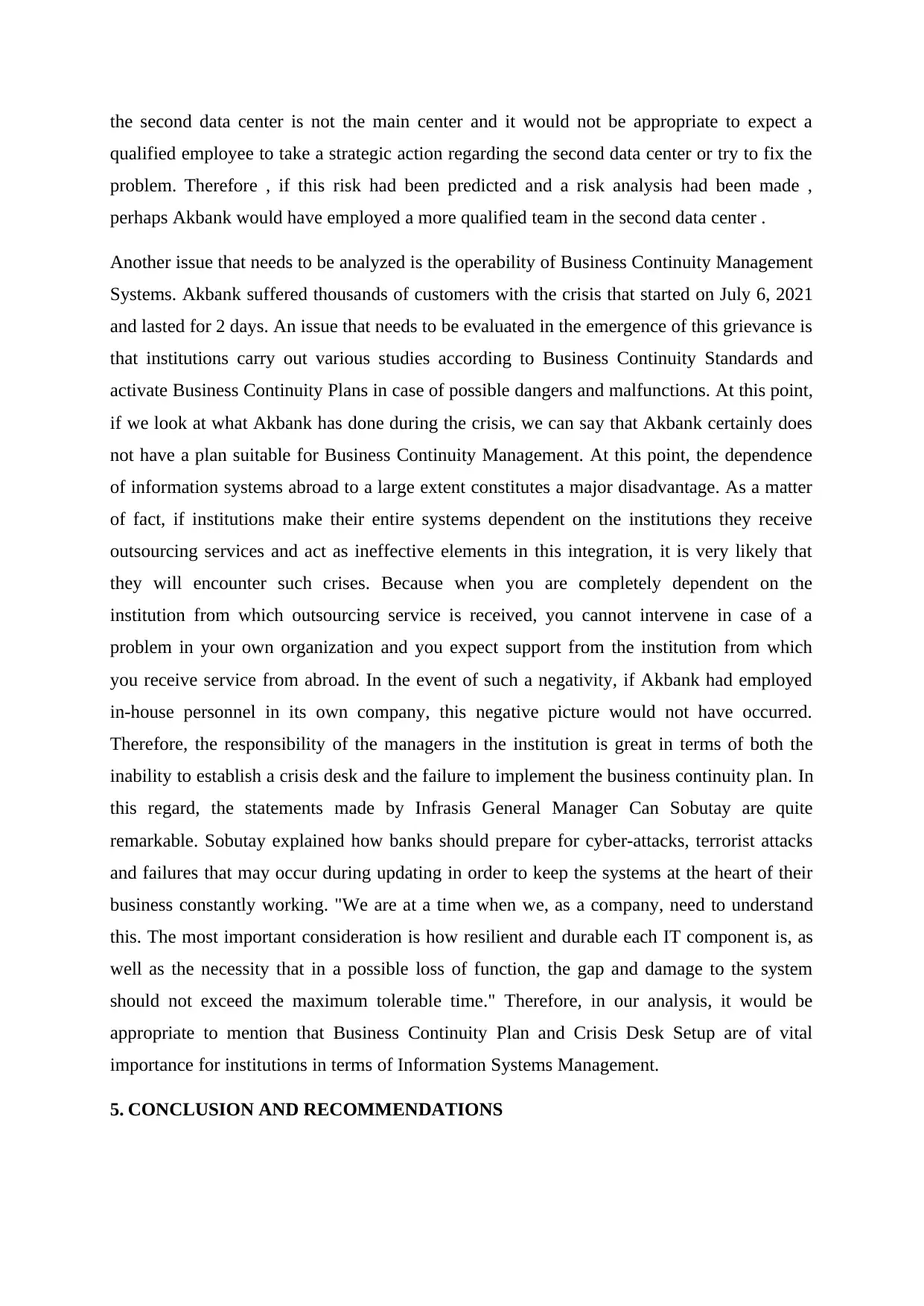
the second data center is not the main center and it would not be appropriate to expect a
qualified employee to take a strategic action regarding the second data center or try to fix the
problem. Therefore , if this risk had been predicted and a risk analysis had been made ,
perhaps Akbank would have employed a more qualified team in the second data center .
Another issue that needs to be analyzed is the operability of Business Continuity Management
Systems. Akbank suffered thousands of customers with the crisis that started on July 6, 2021
and lasted for 2 days. An issue that needs to be evaluated in the emergence of this grievance is
that institutions carry out various studies according to Business Continuity Standards and
activate Business Continuity Plans in case of possible dangers and malfunctions. At this point,
if we look at what Akbank has done during the crisis, we can say that Akbank certainly does
not have a plan suitable for Business Continuity Management. At this point, the dependence
of information systems abroad to a large extent constitutes a major disadvantage. As a matter
of fact, if institutions make their entire systems dependent on the institutions they receive
outsourcing services and act as ineffective elements in this integration, it is very likely that
they will encounter such crises. Because when you are completely dependent on the
institution from which outsourcing service is received, you cannot intervene in case of a
problem in your own organization and you expect support from the institution from which
you receive service from abroad. In the event of such a negativity, if Akbank had employed
in-house personnel in its own company, this negative picture would not have occurred.
Therefore, the responsibility of the managers in the institution is great in terms of both the
inability to establish a crisis desk and the failure to implement the business continuity plan. In
this regard, the statements made by Infrasis General Manager Can Sobutay are quite
remarkable. Sobutay explained how banks should prepare for cyber-attacks, terrorist attacks
and failures that may occur during updating in order to keep the systems at the heart of their
business constantly working. "We are at a time when we, as a company, need to understand
this. The most important consideration is how resilient and durable each IT component is, as
well as the necessity that in a possible loss of function, the gap and damage to the system
should not exceed the maximum tolerable time." Therefore, in our analysis, it would be
appropriate to mention that Business Continuity Plan and Crisis Desk Setup are of vital
importance for institutions in terms of Information Systems Management.
5. CONCLUSION AND RECOMMENDATIONS
qualified employee to take a strategic action regarding the second data center or try to fix the
problem. Therefore , if this risk had been predicted and a risk analysis had been made ,
perhaps Akbank would have employed a more qualified team in the second data center .
Another issue that needs to be analyzed is the operability of Business Continuity Management
Systems. Akbank suffered thousands of customers with the crisis that started on July 6, 2021
and lasted for 2 days. An issue that needs to be evaluated in the emergence of this grievance is
that institutions carry out various studies according to Business Continuity Standards and
activate Business Continuity Plans in case of possible dangers and malfunctions. At this point,
if we look at what Akbank has done during the crisis, we can say that Akbank certainly does
not have a plan suitable for Business Continuity Management. At this point, the dependence
of information systems abroad to a large extent constitutes a major disadvantage. As a matter
of fact, if institutions make their entire systems dependent on the institutions they receive
outsourcing services and act as ineffective elements in this integration, it is very likely that
they will encounter such crises. Because when you are completely dependent on the
institution from which outsourcing service is received, you cannot intervene in case of a
problem in your own organization and you expect support from the institution from which
you receive service from abroad. In the event of such a negativity, if Akbank had employed
in-house personnel in its own company, this negative picture would not have occurred.
Therefore, the responsibility of the managers in the institution is great in terms of both the
inability to establish a crisis desk and the failure to implement the business continuity plan. In
this regard, the statements made by Infrasis General Manager Can Sobutay are quite
remarkable. Sobutay explained how banks should prepare for cyber-attacks, terrorist attacks
and failures that may occur during updating in order to keep the systems at the heart of their
business constantly working. "We are at a time when we, as a company, need to understand
this. The most important consideration is how resilient and durable each IT component is, as
well as the necessity that in a possible loss of function, the gap and damage to the system
should not exceed the maximum tolerable time." Therefore, in our analysis, it would be
appropriate to mention that Business Continuity Plan and Crisis Desk Setup are of vital
importance for institutions in terms of Information Systems Management.
5. CONCLUSION AND RECOMMENDATIONS
⊘ This is a preview!⊘
Do you want full access?
Subscribe today to unlock all pages.

Trusted by 1+ million students worldwide
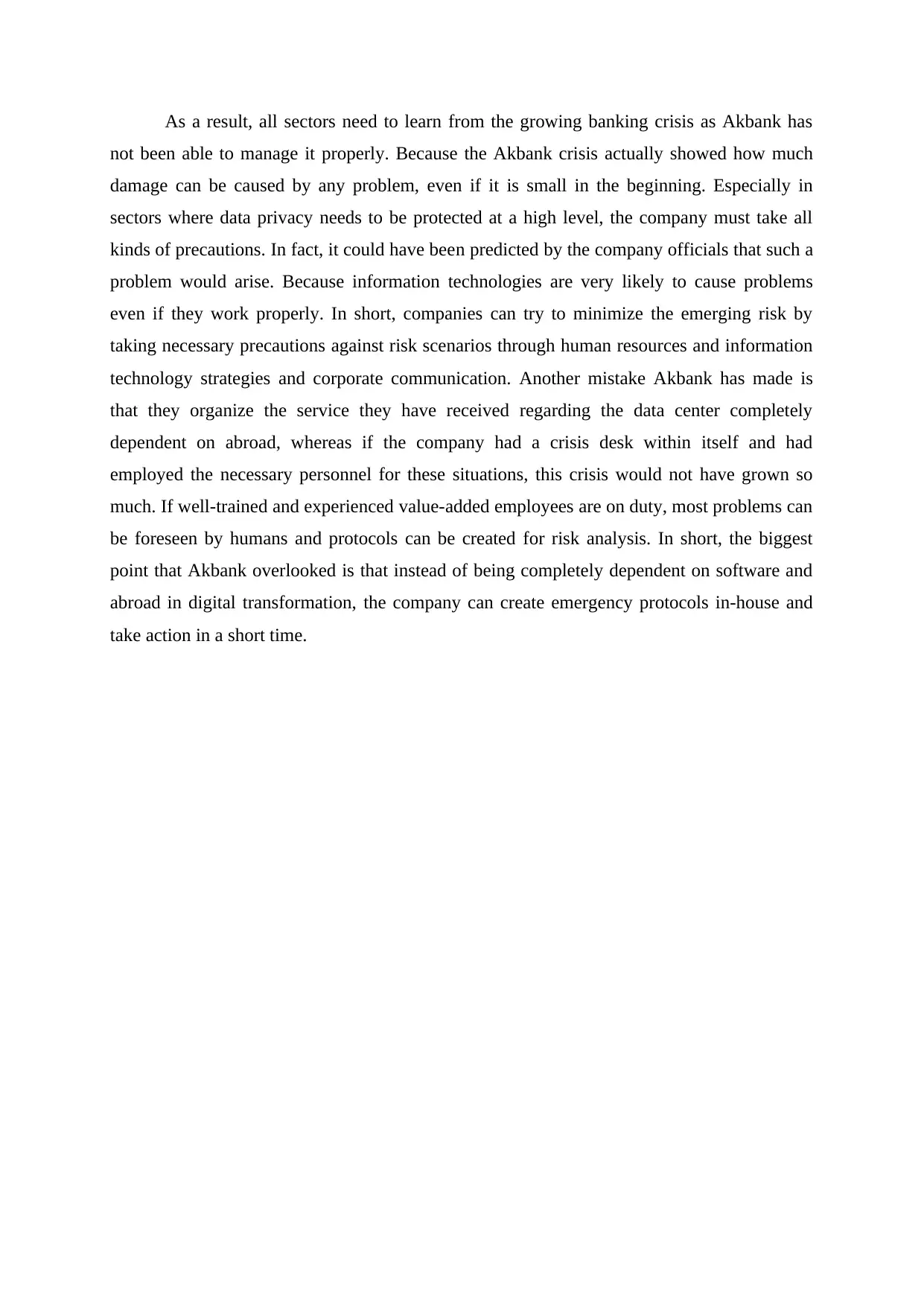
As a result, all sectors need to learn from the growing banking crisis as Akbank has
not been able to manage it properly. Because the Akbank crisis actually showed how much
damage can be caused by any problem, even if it is small in the beginning. Especially in
sectors where data privacy needs to be protected at a high level, the company must take all
kinds of precautions. In fact, it could have been predicted by the company officials that such a
problem would arise. Because information technologies are very likely to cause problems
even if they work properly. In short, companies can try to minimize the emerging risk by
taking necessary precautions against risk scenarios through human resources and information
technology strategies and corporate communication. Another mistake Akbank has made is
that they organize the service they have received regarding the data center completely
dependent on abroad, whereas if the company had a crisis desk within itself and had
employed the necessary personnel for these situations, this crisis would not have grown so
much. If well-trained and experienced value-added employees are on duty, most problems can
be foreseen by humans and protocols can be created for risk analysis. In short, the biggest
point that Akbank overlooked is that instead of being completely dependent on software and
abroad in digital transformation, the company can create emergency protocols in-house and
take action in a short time.
not been able to manage it properly. Because the Akbank crisis actually showed how much
damage can be caused by any problem, even if it is small in the beginning. Especially in
sectors where data privacy needs to be protected at a high level, the company must take all
kinds of precautions. In fact, it could have been predicted by the company officials that such a
problem would arise. Because information technologies are very likely to cause problems
even if they work properly. In short, companies can try to minimize the emerging risk by
taking necessary precautions against risk scenarios through human resources and information
technology strategies and corporate communication. Another mistake Akbank has made is
that they organize the service they have received regarding the data center completely
dependent on abroad, whereas if the company had a crisis desk within itself and had
employed the necessary personnel for these situations, this crisis would not have grown so
much. If well-trained and experienced value-added employees are on duty, most problems can
be foreseen by humans and protocols can be created for risk analysis. In short, the biggest
point that Akbank overlooked is that instead of being completely dependent on software and
abroad in digital transformation, the company can create emergency protocols in-house and
take action in a short time.
1 out of 7
Related Documents
Your All-in-One AI-Powered Toolkit for Academic Success.
+13062052269
info@desklib.com
Available 24*7 on WhatsApp / Email
![[object Object]](/_next/static/media/star-bottom.7253800d.svg)
Unlock your academic potential
Copyright © 2020–2025 A2Z Services. All Rights Reserved. Developed and managed by ZUCOL.




